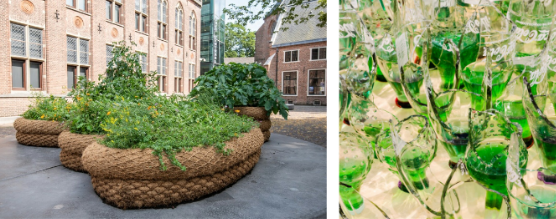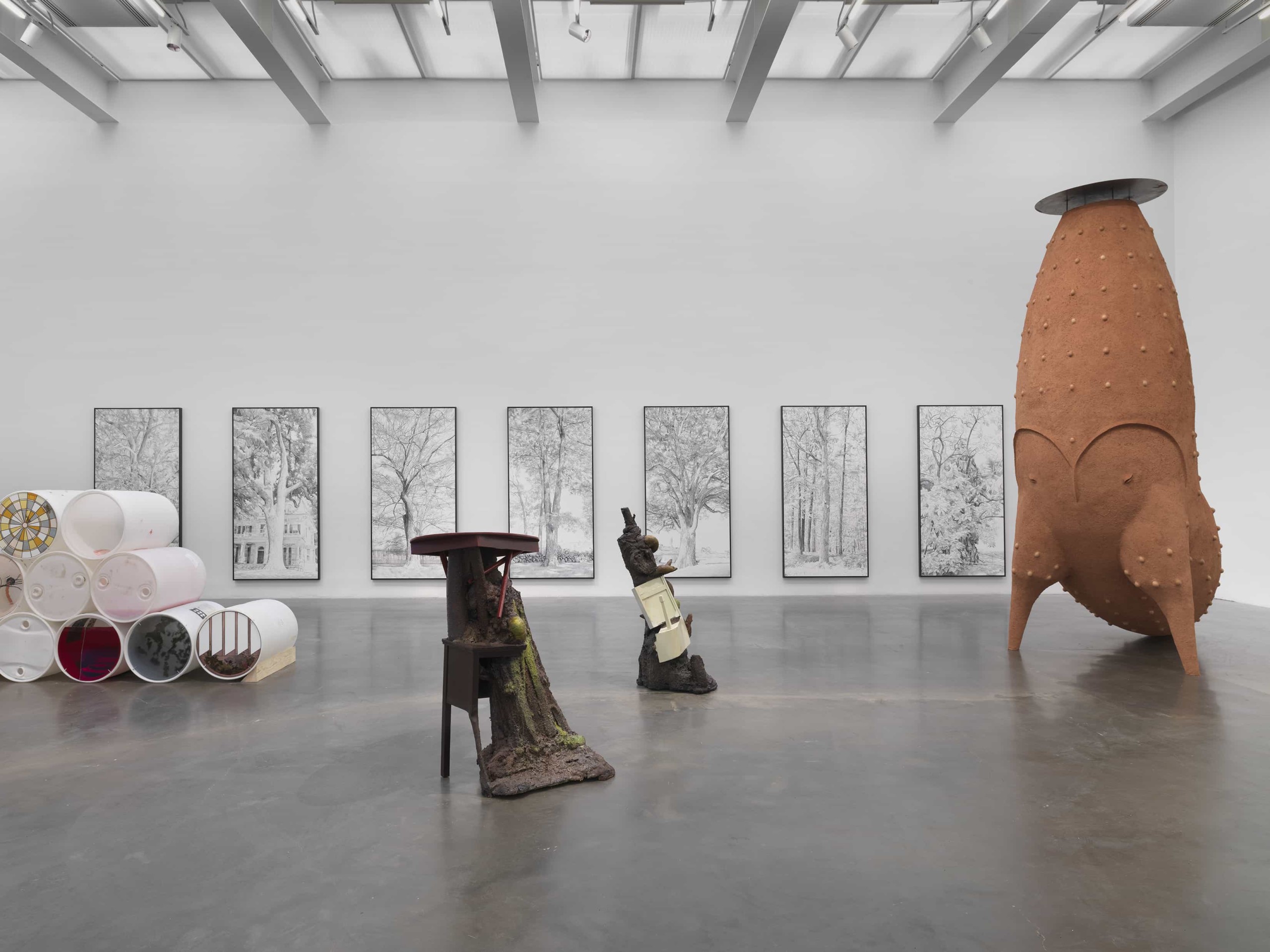2022 marks the 50th anniversary of the famous 1972 Meadows report: “Limits to growth”. Given that the limits in the report have already been surpassed while business continues “as normal”, highlighted by the relative failure of the COP26 last November, the current international exhibitions and biennales are pushing the “reset” button.
The M Leuven museum in Belgium returns to one of the earliest and most revered land artists, Richard Long , with a major dedicated solo exhibition. Otobong Nkanga , the subject of a number of recent shows – including at the Castello di Rivoli, Turin – also goes back to the core elements of earth and water in a significant exhibition spanning four floors at the Kunsthaus Bregenz, Austria. Throughout, she questions the land and the resources that lie underneath: how can we heal and protect it instead of over-exploiting it?

Even gardens, together with human leisure, are now re-explored with a critical approach and a new sense of responsibility. The ecological, historical, geographical and sociological approach to gardens are all analyzed in “The Botanical Revolution ” at Centraalmuseum, Utrecht, Netherlands. The exhibition highlights the garden’s pluralistic purpose as a source of inspiration, a symbol of “hope and resilience”, as well as a representation of inequalities and colonialism. Within the show, Maria Thereza Alves reveals how “typically Dutch” flowers and plants found their way here via colonial trade routes. Meanwhile, Lungiswa Gqunta illustrates the privilege behind garden ownership in South Africa.
Another panorama of exhibitions seek to take advantage of the shock of the recent pandemic and suggest ways to create lasting positive transformations to our society. In particular, space is given to an emerging generation that brings new perspectives. “Soft Water Hard Stone” , the New Museum’s fifth Triennial, recognizes numerous artists re-envisioning traditional models, materials, and techniques beyond established paradigms. Work by 40 emerging artists from around the world, including Thao Nguyen Phan , Gaëlle Choisne and Evgeny Antufiev , address the regenerative potential of the natural world and our inseparable relationship to it, notably through our legacies of colonialism, displacement, and violence.

The second edition of the Thailand Biennale in Korat, entitled “Butterflies Frolicking on the Mud: Engendering Sensible Capital” boldly declares its aim as “detoxifying traditional capitalism (under the Capitalocene) and engendering new capital”. Earlier in the spring, a massive outbreak of beautiful butterflies with white and yellow-green wings happily fluttering around in the mud, had caused a big stir in the local Korat media. Taking this event as a wider metaphor, the exhibition suggests optimistically that there is happiness to be found amid our current anxiety and uncertainty. Not through capitalism or socialism, however, but through “Social Common Capital”. An amazing array of 54 artists, from Olafur Eliasson to Goha Dashtias well as many emerging Thai artists and designers such as Boonserm Premthada – who uses elephant dung – design a new type of relationship with the non-human, including animals, plants and AI. Among the highlights of this biennale is the installation by botanist Stefano Mancuso and PNAT – a think tank of designers and plant scientists – who have installed sensors in a giant banyan tree at a temple, enabling the audience to listen to the tree’s voice through varying light signals.
In this new world, the place of the non-living, including AI and biotechnology, will clearly play a key role. Following up at ZKM, Karlsruhe, Germany, from the landmark exhibition “Critical Zones” , curated by Bruno Latour, is thus “BioMedia” , curated by Peter Weibel, Sarah Donderer and Daria Mille. It “invites visitors to learn about and discuss possible forms of cohabitation between organic and artificial forms of life”, with works by the artists Justine Emard and Jakob Kudsk Steensen among those exhibited.

Last but not least is the unmissable Turbine Hall installation by Anicka Yi , “In Love with the World” at the Tate Modern, London. Here we see “aerobes”, giant jellyfish-like machines, taking over the main entrance to the museum. Through them, the artwork poses the underlying question: “What would it feel like to share the world with machines that could live in the wild and evolve on their own?” A chilling thought to ponder on during a cold Christmas night. Happy holidays!
Stefano Vendramin and Alice Audouin
November/December 2021
Exhibitions mentioned in the article:
Richard Long , M Leuven, Belgium , 22 October 2021 – 20 March 2022
“ Of Cords Curling around Mountains” , Otobong Nkanga, Castello di Rivoli, Turin, Italy, 25 September 2021 – 30 January 2022
Otobong Nkanga , Kunsthaus Bregenz, Bregenz, Austria, 23 October 2021 – 6 February 2022
The Botanical Revolution , Centraalmuseum, Utrecht, Netherlands, 11 September 2021 – 9 January 2022
“Butterflies Frolicking on the Mud: Engendering Sensible Capital” , Thailand Biennale, Korat, 18 December 2021 – 31 March 2022
Soft Water Hard Stone , New Museum, New York, USA, 28 October 2021 – 23 January 2022
BioMedia , ZKM, Karlsruhe, Germany, 18 December 2021 – 28 August 2022
Hyundai Commission: Anicka Yi , Tate Modern, London, UK, 12 October 2021 – 6 February 2022
Credits:
“2021 Triennial: Soft Water Hard Stone,” 2021. Exhibition view: New Museum, New York. Photo: Dario Lasagni
Otobong Nkanage, Unearthed – Abyss , 2021. Installation view, Kunsthaus Bregenz, Bregenz, Austria, 2021. Photo: Markus Tretter. Courtesy of the artist © Otobong Nkanga,
Maria Theresa Alvez, Seeds of Change, The Botanical Revolution , Centraalmuseum, Utrecht, Netherlands, September 11th 2021 to January 9th 2022 Photo Centraal Musuem Utrecht ©Robert Oosterbroek / Lungiswa Gqunta, Lawn 1, The Botanical Revolution , Centraalmuseum, Utrecht, Netherlands, September 11th 2021 to January 9th 2022 ©Robert Oosterbroek
Justine Emard, ZKM, BioMedia, Karlsruhe, Germany, 18 December 2021 – 28 August 2022 / Installation view of Hyundai Commission: Anicka Yi at Tate Modern, October 2021. Photo by Will Burrard Lucas
Find all the articles from Impact Art News n°35 – November/December 2021
To subscribe to Impact Art News (free): here

